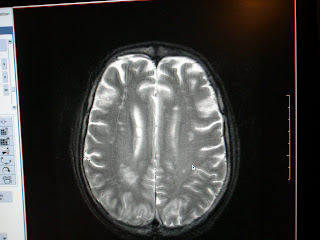

Multiple illdefined irregular altered signal intensity areas involving both parietoccipital regions in parasagital location.
Posterior Reversible Encephalopathy Syndrome (PRES) or Reversible Posterior leukoencephalopathy syndrome (RPLS) is an increasingly recognized neurologic disorder with characteristic computed tomographic (CT) and magnetic resonance (MR) imaging findings, and it is associated with a multitude of diverse clinical entities. These include acute glomerulonephritis, preeclampsia and eclampsia, systemic lupus erythematosus, and thrombotic thrombocytopenic purpura and hemolytic-uremic syndrome, as well as drug toxicity from agents such as cyclosporine, tacrolimus, cisplatin, and erythropoietin. Most, but not all, cases manifest with acute to subacute hypertension, and seizures are also frequent. Classic CT findings are those of bilaterally symmetric low attenuation in the posterior parietal and occipital lobes, whereas MR imaging demonstrates hyperintensity on T2-weighted images in the same distribution.
Two pathophysiologic mechanisms for RPLS have been proposed. One postulates cerebral vasospasm with resulting ischemia within the involved territories, whereas the other posits a breakdown in cerebrovascular autoregulation with ensuing interstitial extravasation of fluid. Diffusion MR imaging can be used to discriminate between these two possibilities, as the cytotoxic edema of cerebral ischemia demonstrates decreased water mobility, whereas vasogenic edema due to cerebrovascular autoregulatory dysfunction results in increased water mobility.
You can find more information on this topic here
No comments:
Post a Comment